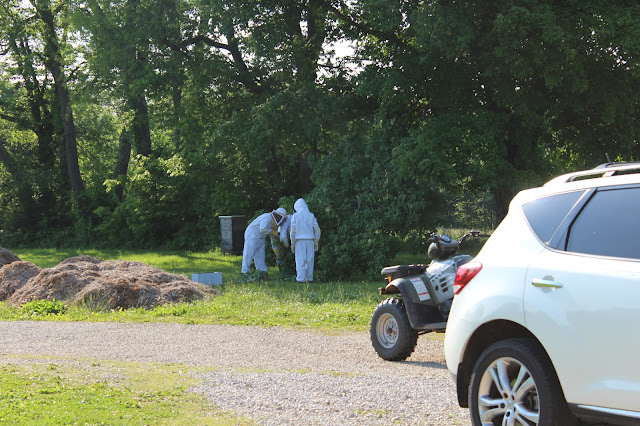With so much going on at the farm this time of year, our
list of “to dos” is very long. On that
list was to getting one of our bee hives split because we could tell the bees
were about to swarm soon and if that happened, we would lose one of our best queens.
When bees swarm the queen leaves and a portion of the bees
go with her. New queens are hatched in
the hive so the hive continues. However,
there is a loss of honey as it takes time to raise a new queen.
So the day came and we were all set to do it in the
afternoon when Dylan came running to the barn announcing, “They are swarming!” Ugh. We
were just a few hours too late.
 |
| The swarm up on the tree branch about 30 feet up. |
Dylan was crushed as this was his best queen. He stood watching the swarm while the rest of us
went back to work. What was so surprising is that Dylan had
already split this hive once earlier this year and started a new queen. So we were surprised that this same hive was
going to swarm again!
(Swarming is the process by which a new honey bee colony is
formed when the queen bee leaves the colony with a large group of worker bees.
In the prime swarm, about 60% of the worker bees leave the original hive
location with the old queen. New queen "cells" are hatched to create a new queen for the hive that remains. But this slows down honey production significantly.)
A few minutes later Dylan came running over to announce that
the bees were in plain view and were only about 25-30 feet off the ground. He asked if we could call our neighbor (and
fellow bee keeper / bee mentor of ours) to see if we could capture the swarm
and still save this queen.
Capture the swarm?
Capture the swarm?

Enter in our multi-talented neighbor, who also happens to be our county’s commissioner, inventor and Christian dad and grandpa too. J
Dylan gave him a call and within minutes he arrived at
our house and assessed the situation. I
must admit I didn’t think there would be much success in this whole event. But Harold’s attitude is one of “we can do it”
and "this looks like fun" and that was just what we needed to lift our spirits! (Queens are not easy or cheap to replace,
so there was sadness all around before Harold showed up!)
With only a few minutes of assessment, Harold began
explaining exactly what we would do, and he did it with such authority that we
all sprang into action. Well, all who
had bee suits… I watched from the window inside the house.
The plan:
Keith would cut the tree branch at the place closest to the tree trunk ... cutting it very slowly so as to lower it down nice an easy where the bees could be captured.
Cutting, cracking, cutting, cracking and then "wham" down it went. Not quite as slowly as they had hoped!The plan:
Keith would cut the tree branch at the place closest to the tree trunk ... cutting it very slowly so as to lower it down nice an easy where the bees could be captured.

They were able to cut the part of the branch that held the bees on each side, and put the cut branch and most of the bees (who are surrounding and protecting their queen) into a bee box.
The box and bees were transported out to the field where our prepared bee hive sat. Slowly they lowered the whole box into the hive. The plan was to leave the box and bees inside the hive for 24-48 hours and block the entrance so they would be forced to stay and hopefully get used to the idea of making this their new home.
It seems to have worked! The next day Dylan and I went out in bee suits and found the queen was there and the workers were already starting to do a bit of work. We removed the box, scraped most of the bees into the hive, and added in the hive frames.
So far they seem to be staying put. We are all thrilled and amazed and grateful for Mr. Harold Gallaher! Now what we thought was a sad situation, turned out to be an opportunity to work together and gain a whole new experience.
Honey production is slowed down in the original hive, but we are grateful to now have 4 hives that seem to be doing well.
"Two are better than one, because they have a good return for their labor:
If either of them falls down, one can help the other up.
But pity anyone who falls and has no one to help them up.
- Ecclesiastes 4:9-10
























